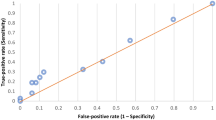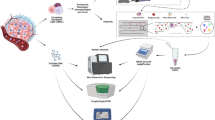Abstract
Malignant melanoma (MM) is thought to arise by sequential accumulation of genetic alterations in normal melanocytes. Previous cytogenetic and molecular studies indicated the 9p21 as the chromosomal region involved in MM pathogenesis. In addition to the CDKN genes (p16/CDKN2A, p15/CDKN2B and p19ARF, frequently inactivated in familial MM), widely reported data suggested the presence within this region of other melanoma susceptibility gene(s). To clearly assess the role of the 9p21 region in sporadic melanoma, we evaluated the presence of microsatellite instability (MSI) and loss of heterozygosity (LOH) in primary tumours as well as in synchronous or asynchronous metastases obtained from the same MM patients, using 9 polymorphic markers from a 17-cM region at 9p21. LOH and MSI were found in 27 (41%) and 11 (17%), respectively, out of 66 primary tumours analysed. In corresponding 58 metastases, MSI was found at higher rate (22; 38%), whereas a quite identical pattern of allelic deletions with 27 (47%) LOH+ cases were observed. Although the CDKN locus was mostly affected by LOH, an additional region of common allelic deletion corresponding to marker D9S171 was also identified. No significant statistical correlation between any 9p21 genetic alteration (LOH, MSI or both) and clinicopathological parameters was observed. © 2000 Cancer Research Campaign http://www.bjcancer.com
Similar content being viewed by others
Article PDF
Change history
16 November 2011
This paper was modified 12 months after initial publication to switch to Creative Commons licence terms, as noted at publication
References
Bahuau M, Vidaud D, Jenkins RB, Bieche I, Kimmel DW, Assouline B, Smith JS, Alderete B, Cayuela J-M, Harpey J-P, Caille B and Vidaud M (1998) Germ-line deletion involving the INK4 locus in familial proneness to melanoma and nervous system tumors. Cancer Res 58: 2298–2303
Batova A, Diccianni MB, Yu JC, Nobori T, Link MP, Pullen J and Yu AL (1997) Frequent and selective methylation of p15 and deletion of both p15 and p16 in T-cell acute lymphoblastic leukemia. Cancer Res 57: 832–836
Berwick M and Halpern AH (1997) Melanoma epidemiology. Curr Opin Oncol 9: 178–182
Birindelli S, Tragni G, Bartoli C, Ranzani GN, Rilke F, Pierotti MA and Pilotti S (2000) Detection of microsatellite alterations in the spectrum of melanocytic nevi in patients with or without individual or family history of melanoma. Int J Cancer 86: 255–261
Borg A, Johansson U, Johansson O, Håkansson S, Westerdahl J, Måsbäck A, Olsson H and Ingvar C (1996) Novel p16 mutation in familial melanoma in Southern Sweden. Cancer Res 56: 2497–2500
Cairns P, Polascik TJ, Eby Y, Tokino K, Califano J, Merlo A, Mao L, Herath J, Jenkins R and Westra W (1995) Frequency of homozygous deletion at p16/CDKN2 in primary human tumours. Nat Genet 11: 210–212
Costello JF, Berger MS, Huang HS and Cavenee WK (1996) Silencing of p16/CDKN2 expression in human gliomas by methylation and chromatin condensation. Cancer Res 56: 2405–2410
Fitzgerald MG, Harkin DP, Silva-Arrieta S, MacDonald DJ, Lucchina LC, Unsal H, O'Neil E, Koh J, Finkelstein DM, Isselbacher KJ, Sober AJ and Haber DA (1996) Prelevance of germ-line mutations in p16, p19ARF, and CDK4 in familial melanoma: analysis of a clinic-based population. Proc Natl Acad Sci USA 93: 8541–8545
Flores JF, Walker GJ, Glendening JM, Haluska FG, Castresana JS, Rubio MP, Pastorfide GC, Boyer LA, Kao WH, Bulyk ML, Barnhill RL, Hayward NK, Housman DE and Fountain JW (1996) Loss of the p16INK4a and p15INK4b genes, as well as neighboring 9p21 markers, in sporadic melanoma. Cancer Res 56: 5023–5032
Foulkes WD, Flanders TY, Pollock PM and Hayward NK (1997) The CDKN2A (p16) gene and human cancer. Molec Med 3: 5–20
Fountain JW, Karayiorgou M, Ernstoff MS, Kirkwood JM, Vlock DR, Titus-Ernstoff L, Bouchard B, Vijayasaradhi S, Houghton AN, Lahti J, Kidd VJ, Housman DE and Dracopoli NC (1992) Homozygous deletion within human chromosome band 9p21 in melanoma. Proc Natl Acad Sci USA 89: 10557–10561
Fujimoto A, Morita R, Hatta N, Takehara K and Takata M (1999) p16INK4a inactivation is not frequent in uncultured sporadic primary cutaneous melanoma. Oncogene 18: 2527–2532
Gonzalgo ML, Bender CM, You EH, Glendening JM, Flores JF, Walker GJ, Hayward NK, Jones PA and Fountain JW (1997) Low frequency of p16/CDKN2A methylation in sporadic melanoma: comparative approaches for methylation analysis of primary tumors. Cancer Res 57: 5336–5347
Haluska FG and Hodi FS (1998) Molecular genetics of familial cutaneous melanoma. J Clin Oncol 16: 670–682
Healy E, Rehman I, Angus B and Rees JL (1995) Loss of heterozygosity in sporadic primary cutaneous melanoma. Genes Chromosomes Cancer 12: 152–156
Healy E, Sikkin S and Rees JL (1996) Infrequent mutation of p16INK4 in sporadic melanoma. J Invest Dermatol 107: 318–321
Healy E, Belgaid C, Takata M, Harrison D, Zhu NW, Burd DA, Rigby HS, Matthews JN and Rees JL (1998) Prognostic significance of allelic losses in primary melanoma. Oncogene 16: 2213–2218
Kamb A, Shattuck-Eidens D, Eeles R, Liu Q, Gruis NA, Ding W, Hussey C, Tran T, Miki Y, Weaver-Feldhaus J, McClure M, Aitken JF, Anderson DE, Bergman W, Frants R, Goldar DE, Green A, MacLennan R, Martin NG, Meyer LJ, Youl P, Zone JJ, Skolnick MH and Cannon Albright LA (1994a) Analysis of the p16 gene (CDKN2) as a candidate for the chromosome 9p melanoma susceptibility locus. Nature Genet 8: 22–26
Kamb A, Gruis NA, Weaver-Feldhaus J, Liu Q, Harshman K, Tavtigian SV, Stockert E, Day RS, Johnson BE and Skolnick MH (1994b) A cell cycle regulator potentially involved in genesis of many tumor types. Science 264: 436–440
Kumar R, Smeds J, Lundh-Rozell B and Hemminki K (1999) Loss of heterozygosity at chromosome 9p21 (INK4-p14ARF locus): homozygous deletions and mutations in the p16 and p14ARF genes in sporadic primary melanomas. Melanoma Res 9: 138–147
Lee JY, Dong SM, Shin MS, Kim SY, Lee SH, Kang SJ, Lee JD, Kim CS, Kim SH and Yoo NJ (1997) Genetic alterations of p16INK4a and p53 genes in sporadic dysplastic nevus. Biochem Biophys Res Commun 237: 667–672
Little M and Wainwright B (1995) Methylation and p16: suppressing the suppressor. Nature Med 1: 633–634
Liu L, Godstein AM, Tucker MA, Brill H, Gruis NA, Hogg D and Lassam NJ (1997) Affected members of melanoma-prone families with linkage to 9p21 but laking mutations in CDKN2A do not harbor mutations in the coding regions of either CDKN2B or p19ARF. Genes Chromosomes Cancer 19: 52–54
Liu L, Dilworth D, Gao L, Monzon J, Summers A, Lassam N and Hogg D (1999) Mutation of the CDKN2A 5′ UTR creates an aberrant initiation codon and predisposes to melanoma. Nat Genet 21: 128–132
Merbs SL and Sidransky D (1999) Analysis of p16 (CDKN2/MTS-1/INK4A) alterations in primary sporadic uveal melanoma. Invest Ophthalmol Vis Sci 40: 779–783
Merlo A, Herman JG, Mao L, Lee DJ, Gabrielson E, Burger PC, Baylin SB and Sidransky D (1995) 5′ CpG island methylation is associated with transcriptional silencing of the tumor suppressor p16/CDKN2/MTS1 in human cancers. Nature Med 1: 686–692
Morita R, Fujimoto A, Hatta N, Takehara K and Takata M (1998) Comparison of genetic profiles between primary melanomas and their metastases reveals genetic alterations and clonal evolution during progression. J Invest Dermatol 111: 919–924
Nobori T, Miura K, Wu DJ, Lois A, Takabayashi K and Carson DA (1994) Deletions of the cyclin dependent Kinase-4 inhibitor gene in multiple human cancers. Nature 368: 753–756
Ohgaki K, Minobe K, Kurose K, Iida A, Habuchi T, Ogawa O, Kubota Y, Akimoto M and Emi M (1999) Two target regions of allelic loss on chromosome 9 in urinary-bladder cancer. Jpn J Cancer Res 90: 957–964
Ohta M, Berd D, Shimizu M, Nagai H, Cotticelli MG, Mastrangelo M, Shields JA, Shields CL, Croce CM and Huebner K (1996) Deletion mapping of chromosome 9p21-p22 surronding the CDKN2 locus in melanoma. Int J Cancer 65: 762–767
Palmieri G, Strazzullo M, Ascierto PA, Satriano SM, Daponte A and Castello G for the Melanoma Cooperative Group (1999) Polymerase chain reaction-based detection of circulating melanoma cells as an effective marker of tumor progression. J Clin Oncol 17: 304–311
Perinchery G, Bukurov N, Nakajima K, Chang J, Li LC and Dahiya R (1999) High frequency of deletion on chromosome 9p21 may harbor several tumor-suppressor genes in human prostate cancer. Int J Cancer 83: 610–614
Peris K, Keller G, Chimenti S, Amantea A, Kerl H and Hofler H (1995) Microsatellite instability and loss of heterozygosity in melanoma. J Invest Dermatol 105: 625–628
Pisano M, Cossu A, Persico I, Palmieri G, Angius A, Casu G, Palomba G, Sarobba MG, Rocca PC, Dedola MF, Olmeo N, Pasca A, Budroni M, Marras V, Pisano A, Farris A, Massarelli G, Pirastu M and Tanda F (2000) Identification of a founder BRCA2 mutation in Sardinia. Br J Cancer 82: 553–559
Platz A, Hanson J, Mansson-Brahme E, Lagerlöf B, Linder S, Lundqvist E, Sevigny P, Inganäs M and Ringborg U (1997) Screening of germline mutations in the CDKN2A and CDKN2B genes in Swedish families withh ereditary cutaneous melanoma. J Natl Cancer Inst 89: 697–702
Pollock PM, Pearson JV and Hayward NK (1996) Compilation of somatic mutations of the CDKN2 gen in human cancers: non-random distribution of base substitutions. Genes Chromosom Cancer 15: 77–88
Reed JA, Loganzo F, Shea CR, Walker GJ, Flore JF, Glendening JM, Bogdany JK, Shiel MJ, Haluska FG, Fountain JW and Albino AP (1995) Loss of expression of the p16/cyclin-dependent kinase inhibitor 2 tumor suppressor gene in melanocityc lesion correlates with invasive stage of tumor progression. Cancer Res 55: 2713–2718
Ruben A, Babilas P, Baron JM, Hofheinz A, Neis M, Sels F and Sporkert M (2000) Analysis of tumor cell evolution in a melanoma: evidence of mutational and selective pressure for loss of p16ink4 and for microsatellite instability. J Invest Dermatol 114: 14–20
Ruiz A, Puig S, Lynch M, Castel T and Estivill X (1998) Retention of the CDKN2A locus and low frequency of point mutations in primary and metastatic cutaneous malignant melanoma. Int J Cancer 76: 312–316
Schuchter LM (1997) Melanoma and other skin neoplasms. Curr Opin Oncol 9: 175–177
Smith-Sorenson B and Hoving E (1996) CDKN2A [P16(INK4A)] somatic and germline mutations. Hum Mutat 7: 294–303
Soufir N, Avril M-F, Chompret A, Demenais F, Bombled J, Spatz A, Stoppa-Lyonnet D, the French Familial Melanoma Study Group Bernard J and Bressac-de Paillerets B (1998) Prevalence of p16 and CDK4 germline mutations in 48 melanoma-prone families in France. Hum Mol Genet 7: 209–216
Talwalkar VR, Scheiner M, Hedges LK, Butler MG and Schwartz HS (1998) Microsatellite instability in malignant melanoma. Cancer Genet Cytogenet 104: 111–114
Wagner SN, Wagner C, Briedigkeit L and Goos M (1998) Homozygous deletion of the p16INK4a and the p15INK4b tumour suppressor genes in a subset of human sporadic cutaneous malignant melanoma. Br J Dermatol 138: 13–21
Zuo L, Weger J, Yang Q, Goldstein AM, Tucker MA, Walker GJ, Hayward N and Dracopoli NC (1996) Germline mutations in the p16INK4a binding domain of CDK4 in familial melanoma. Nature Gen 12: 97–99
Author information
Authors and Affiliations
Consortia
Rights and permissions
From twelve months after its original publication, this work is licensed under the Creative Commons Attribution-NonCommercial-Share Alike 3.0 Unported License. To view a copy of this license, visit http://creativecommons.org/licenses/by-nc-sa/3.0/
About this article
Cite this article
Palmieri, G., Cossu, A., Ascierto, P. et al. Definition of the role of chromosome 9p21 in sporadic melanoma through genetic analysis of primary tumours and their metastases. Br J Cancer 83, 1707–1714 (2000). https://doi.org/10.1054/bjoc.2000.1513
Received:
Revised:
Accepted:
Published:
Issue date:
DOI: https://doi.org/10.1054/bjoc.2000.1513
Keywords
This article is cited by
-
A phase II study of cell cycle inhibitor UCN-01 in patients with metastatic melanoma: a California Cancer Consortium trial
Investigational New Drugs (2012)
-
High Frequency of p16INK4A Promoter Methylation in NRAS-Mutated Cutaneous Melanoma
Journal of Investigative Dermatology (2010)
-
Genome-wide association study identifies variants at 9p21 and 22q13 associated with development of cutaneous nevi
Nature Genetics (2009)
-
LOH analysis of free DNA in the plasma of patients with mucosal malignant melanoma in the head and neck
International Journal of Clinical Oncology (2007)
-
Increased C-MYC copy numbers on the background of CDKN2A loss is associated with improved survival in nodular melanoma
Journal of Cancer Research and Clinical Oncology (2007)



